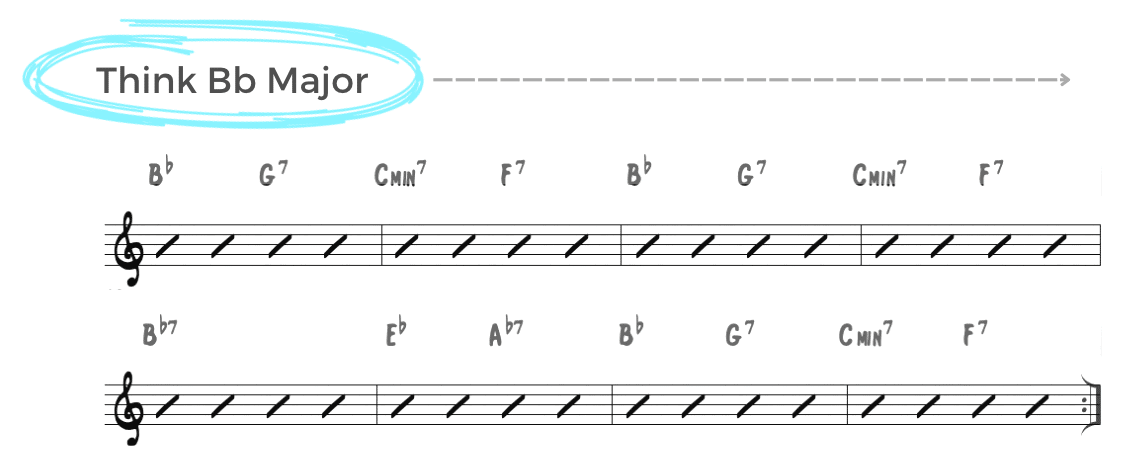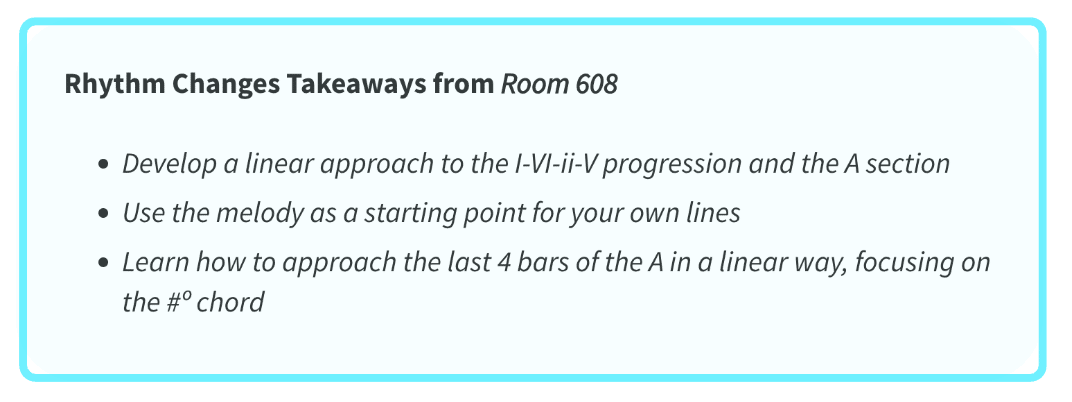As musicians, we often treat the songs of the jazz repertoire in the same predictable way. We learn the chords, memorize the notes of the melody, and then we skip ahead to the important stuff – Improvising our own solos over the tune…
But is this really all that jazz standards are good for??
For the serious improviser and the players that sound the best, these tunes are much more than notes to memorize and rehearse in the practice room.
The truth is, these melodies are a doorway into the inner workings of every jazz standard – a path to mastering the harmonic and melodic language that many players skip over.
The melodies of the jazz repertoire aren’t just notes to learn. There is a tradition, a musical style, and a language of playing over these progressions and forms – and these melodies are the blueprint to playing these tunes in a musical way.
Today we’ll show you why familiar jazz melodies can be the missing link between notes on a page and actual musical techniques and concepts that you can employ in your own solos.
…so when you leave the practice room after learning a tune you aren’t left with a sequence of memorized notes, rather language, techniques, and a mastery of the actual song form.
Below we’ll focus on two song forms central to this music – the Blues and Rhythm Changes – exploring 6 standard jazz melodies and the wealth of musical knowledge they contain.
Inside, you’ll learn why spending the time to study and completely learn the melodies of the jazz repertoire will help you:
- Learn language and actionable lines to apply to common progressions
- Develop ways of navigating tunes beyond individual chords & scales
- Gain musical proficiency and mastery in all keys
- and add new tunes to your musical repertoire along the way!
Let’s jump in…
The Blues
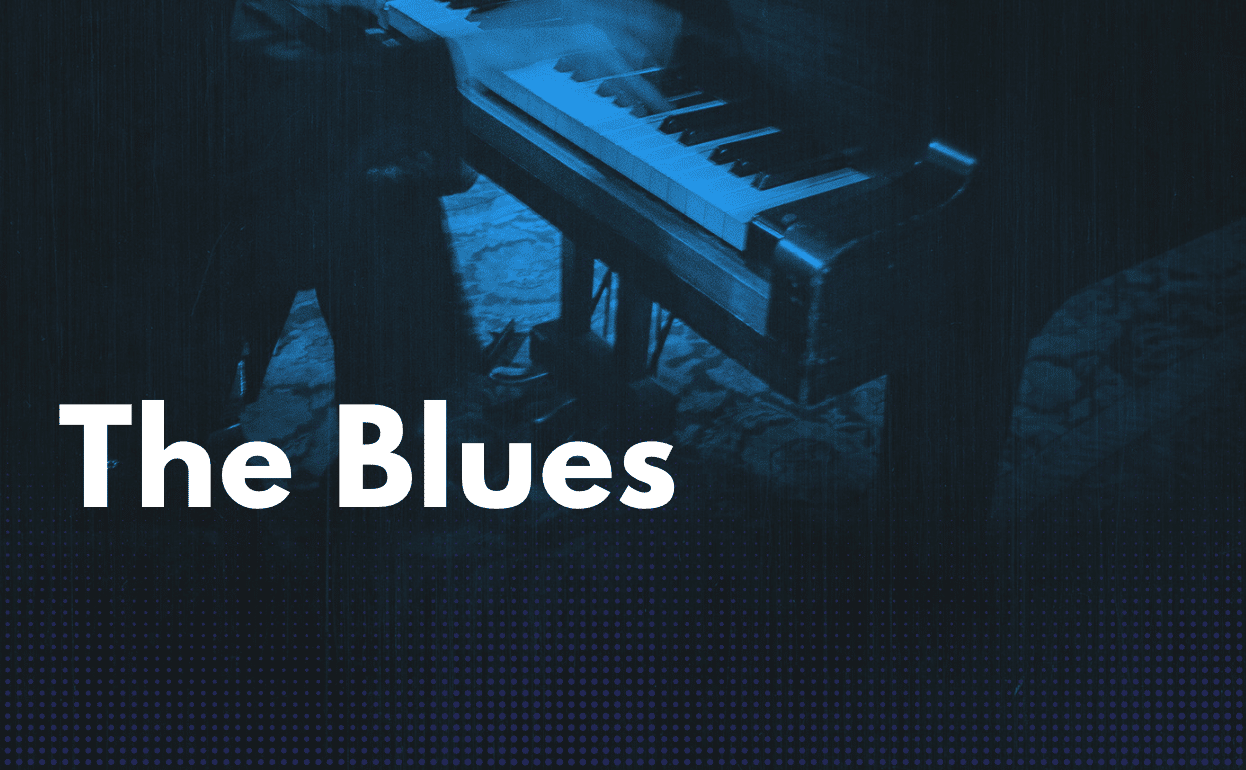
The Blues is one of the central forms and to jazz improvisation, and every improviser should have tools & techniques for creating musical ideas over this form…
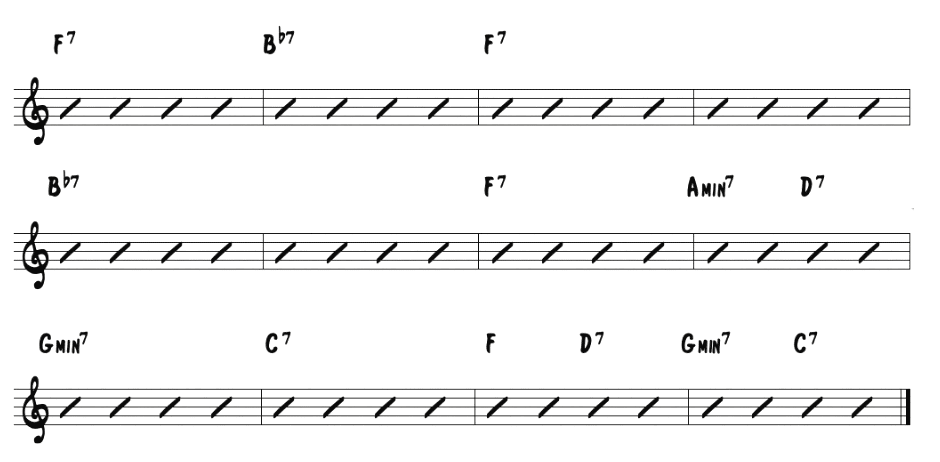
But the blues is much more than 12 bars or a sequence of chords to memorize…
And this goes back to the dilemma you face when learning any new tune or song form as an improviser. You’ve got a chord progression to navigate, but what exactly is the next step in creating a solo that goes beyond scales to match the chords??
This is where a strong musical model – a.k.a. the melody – can shed some light on the art of creating musical ideas over a particular song form and the tradition that comes with it.
Below, we’ll take 3 Blues melodies and uncover the different lessons each will teach us about improvising over this form…
I. Tenor Madness
The first blues melody we’ll look at is Tenor Madness from Sonny Rollins’s album recorded with John Coltrane:
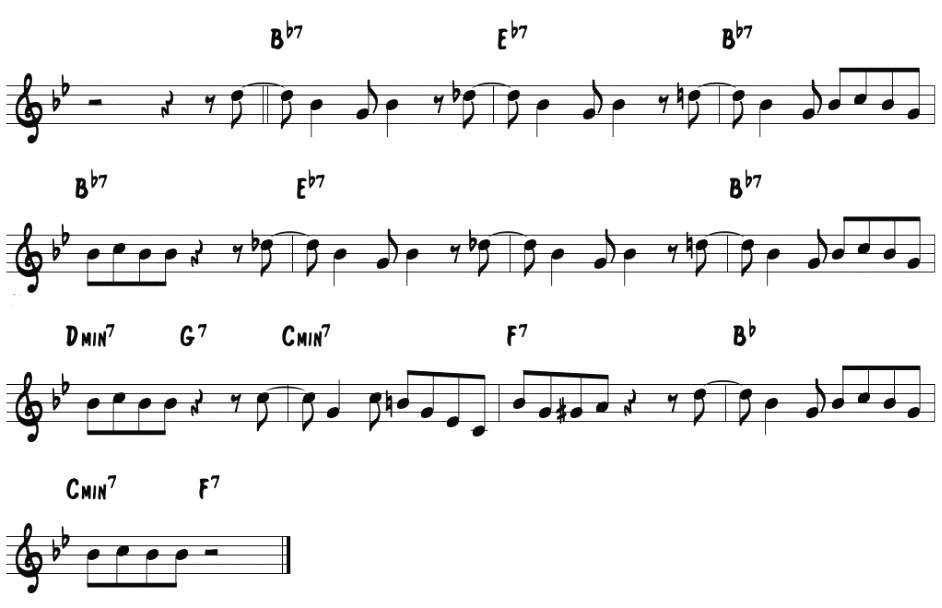
As you learn any of these melodies below and begin to break them apart, ask yourself:
- “Why does this melody sound good?”
- “What elements make it unique or distinctive?”
- “How does it navigate the chord progression?”
- “What does it tell me about soloing over the song form?”
Rather than a collection of notes to memorize, your goal is to extract the musical techniques and language of the melody in order to develop a solo approach to the tune..
We’ll start with 3 musical lessons that the melody of Tenor Madness teaches us about playing the blues…
1. Create Simple Melodic Statements
The first thing you might notice about this tune is the simplicity of the melodic material. The entire melody is built around a simple musical statement starting in Bb:
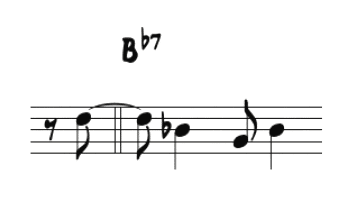
The focus here isn’t really about specific notes, rather a musical idea over a sound. And while this may seem inconsequential or unimportant, it’s an essential lesson to learn in playing any solo.
You need to develop the ability to create musical ideas that aren’t centered around scales, ideas with defined rhythm and shape that you can sing. This is central to playing the blues…
Improvising over the blues or any other tune isn’t about playing over a specific chord or an individual progression, it’s about playing musical ideas over the song form and telling a story.
While this concept is easy to grasp in theory, it’s a little more involved in practice, including things like learning language, transcribing, and understanding harmony. But no matter where you are, musical statements should be a central part of any solo you play.
When you’re about to start a solo, are you thinking about theory and scales or hearing musical ideas?

Your goal should always be to play musical statements and ideas that you’re hearing!
The melody of Tenor Madness demonstrates a way to approach the blues with melodic statements. Remember, an effective melodic idea doesn’t have to be complicated – in this case it’s simply the root, 3rd, and 6th with a clearly defined rhythm.
And this small statement becomes the genesis of melodic material for the tune. Listen to how this melodic statement is continued throughout the form:

The next time you play over a blues, try to approach your solo with a clearly defined melodic statement!
* Wondering how to create musical ideas and melodic statements? Check out our course Melodic Power!

2. Major and minor 3rds between I and IV
One of the defining features of the blues is the dichotomy between the major 3rd on the I chord and the b7 (or minor 3rd in the tonic) on the IV chord:

You can see how the melody to Tenor Madness follows this larger format moving between the D on Bb7 chord and Db on the Eb7 chord:

This is a valuable movement and resolution to incorporate in your approach to the Blues. Visualize and learn this half-step movement over the first 8 bars of the blues in all keys, starting on the 3rd of the I chord:
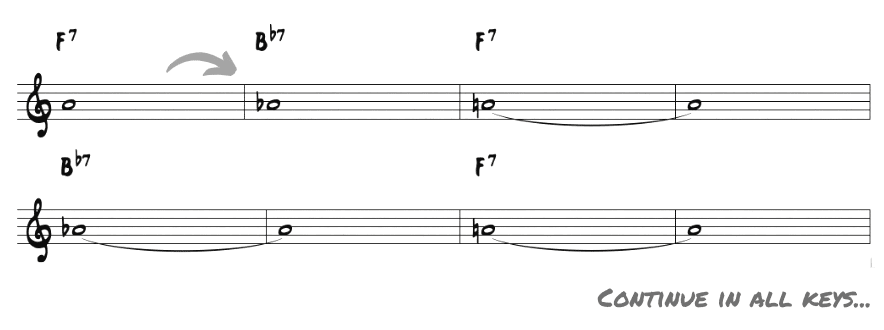
The next step is to incorporate a melodic approach that utilizes this harmonic motion. Start by learning the original melodic line in all keys:

Then create variations on the original line or come up with your own musical ideas. Here’s a simple idea based around this framework:
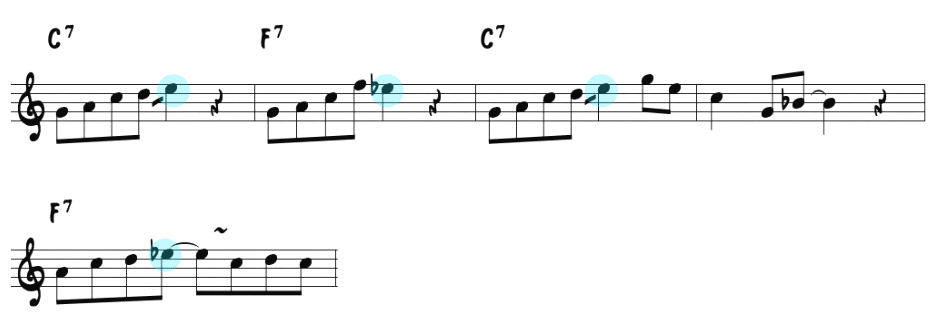
3. The ii-V in the Blues
One of the transitions in the blues that you need to know is the ii-V at the end of the form in the 9th and 10th bars:
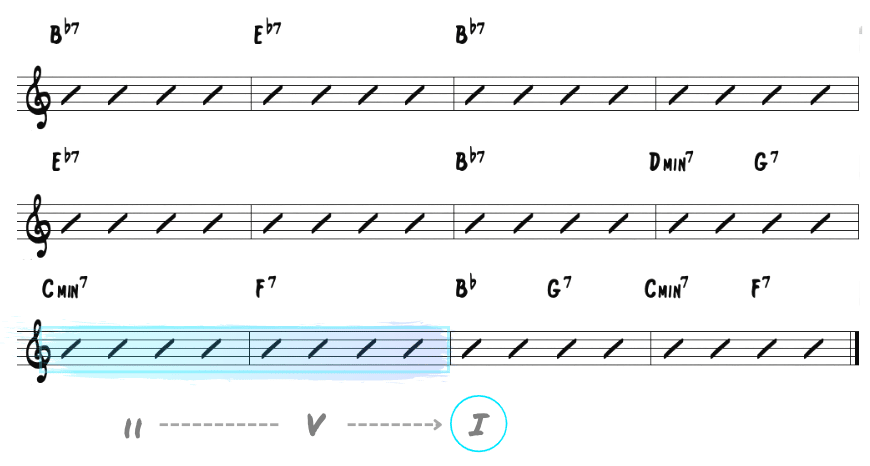
And this is the one part of the Tenor Madness melody that sticks out in a harmonic sense from the rest of the phrases.
Check out how the line over the ii-V in the 9th and 10th bars navigates this ii-V in a linear way that matches with the rest of the tune:

A ii-V with half-step descending motion from the root of the ii chord (C) to the 3rd of the V chord (A)

Also notice the rhythmic content of this ii-V phrase. The rhythm here matches the other phrases in the tune and doesn’t resolve predictably on the bar line:

In other words, the ii-V is incorporated seamlessly into the musical ideas of the larger tune, and the same should be true of your solos.
Here are a few practice ideas to ingrain this concept. Visualize and hear the blues form in all keys, focusing on where the ii-V occurs in the 9th & 10th bars:
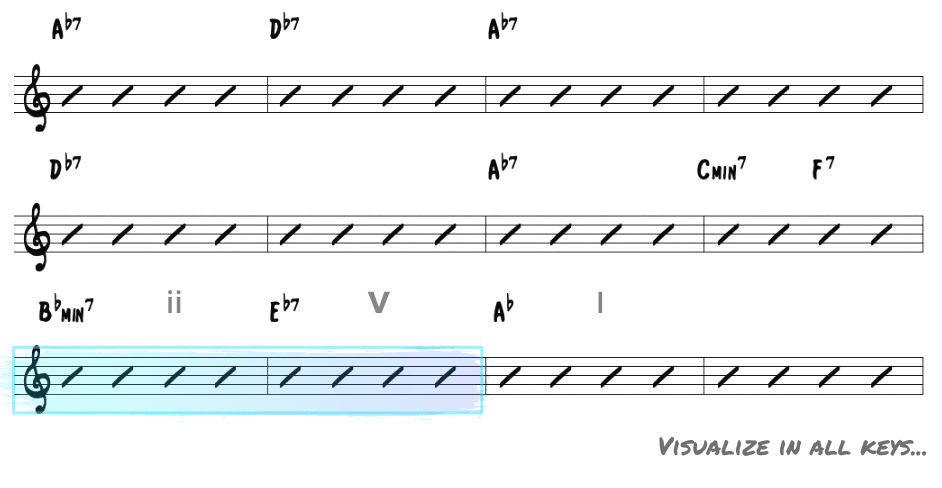
Then learn the Tenor Madness ii-V in all keys – a melodic and rhythmically interesting approach to a standard chord progression
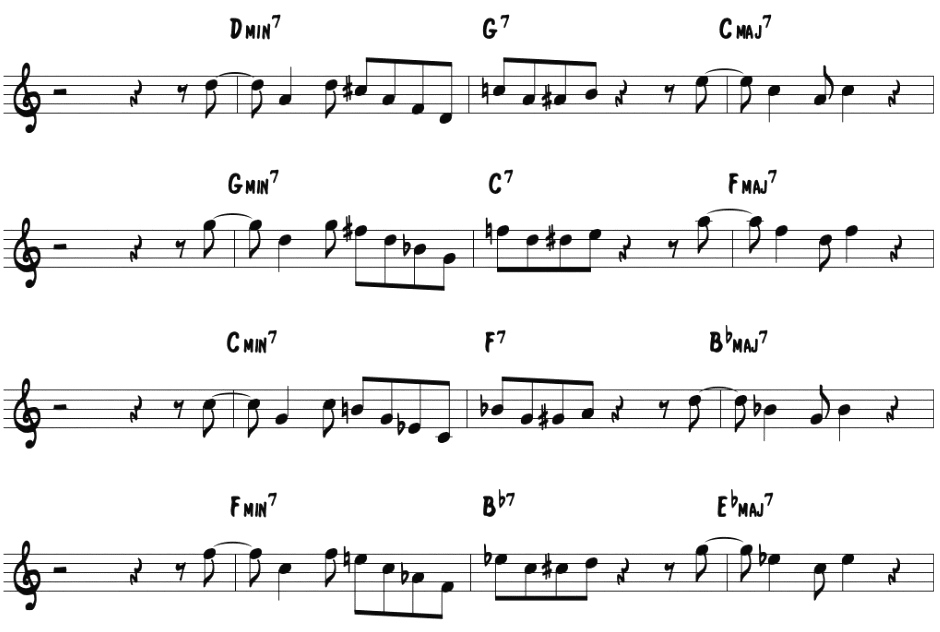
As you practice incorporating this approach into the blues, it helps to have some ii-V language and techniques that you can execute in all keys. Use these ideas to create variations on the original ii-V line.
Finally, it’s valuable to learn this melody (and the others below) in new keys, slowly going through each one until it’s ingrained. This will test your mastery of not only new keys, but the related chord tones, progressions, language, resolutions, and lines in different harmonic centers.
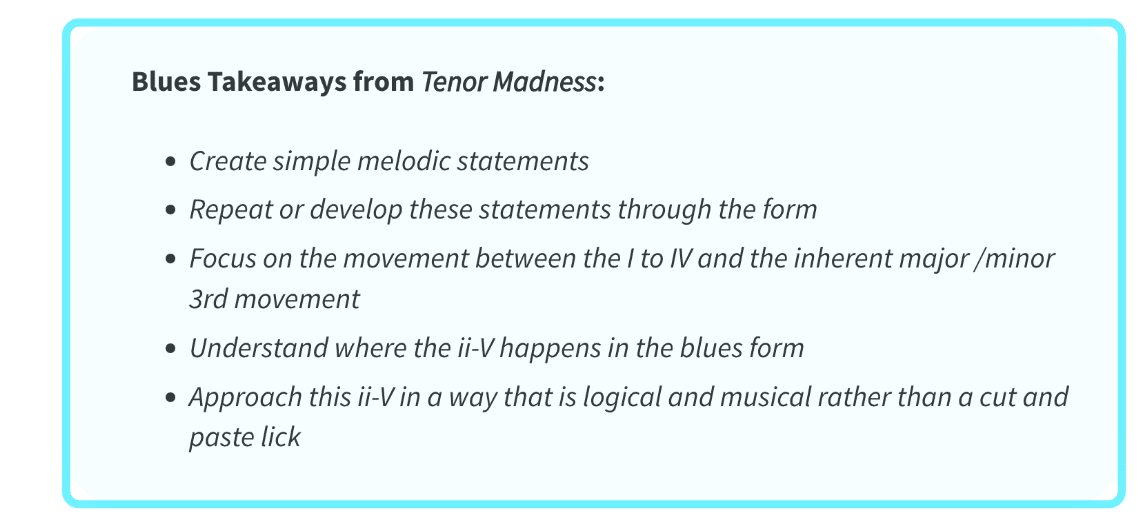
II. Sandu
Next, we’ll take a look at another well know blues standard – Clifford Brown’s Sandu:
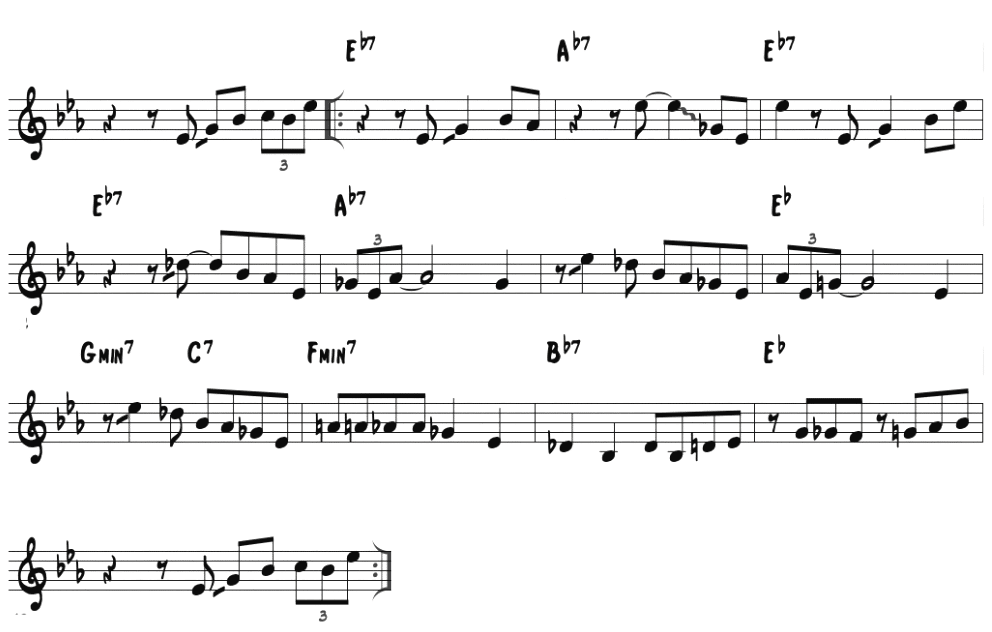
As you can hear, this melody provides some different insights to improvising over the blues…
1. Blues language and blues statements
One aspect of playing the blues is learning the common blues vocabulary that every great player draws upon and implementing this language in a musical way over the form.
The melody to Sandu is a great way to start learning this musical tradition:

Remember, it’s not just the notes, but also the style and character with which these statements are played…building on the idea of creating musical statements with style rather than simply “playing” each chord.
To practice, isolate specific melodic phrases from the melody and learn this blues language in all keys. You might start with the opening statement:
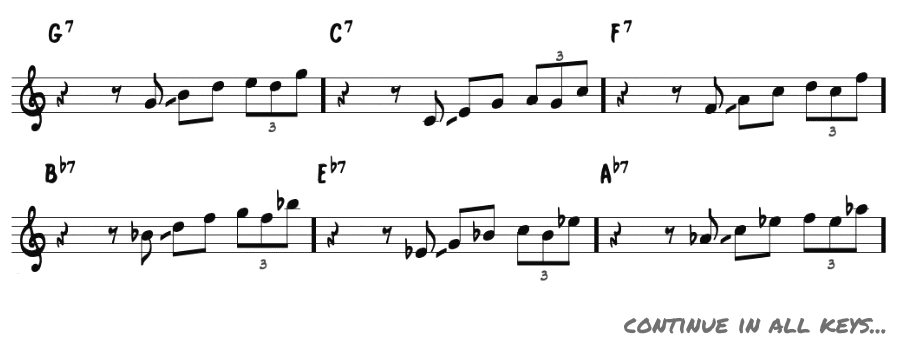
Then isolate some of the other ideas and phrases from the melody and work them out in other keys…
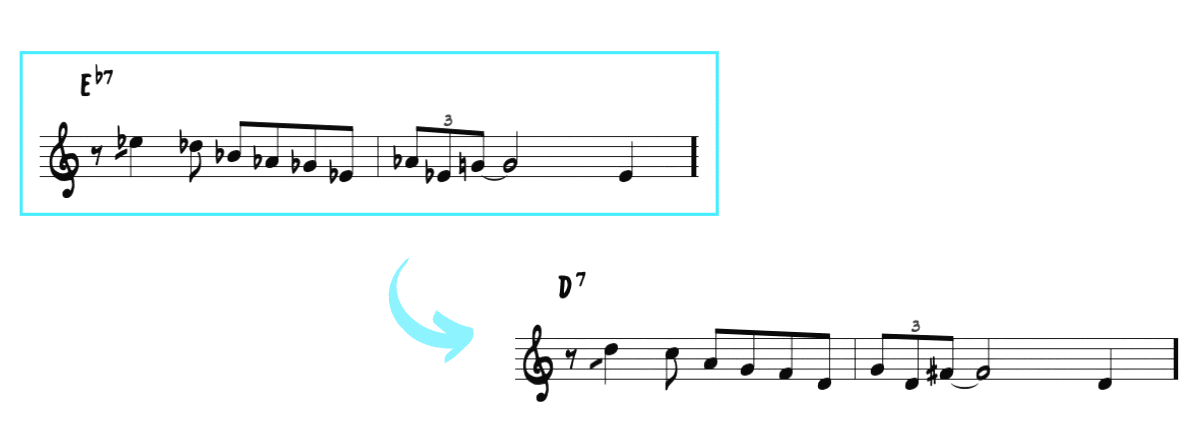
As always, it’s valuable to learn the entire melody of Sandu in all keys, ingraining blues statements and the blues form in every key.
2. Highlighting the “blue notes”
A central part of playing blues statements is hearing and incorporating what we call “blue notes.” And this is something that you hear in the melody to Sandu…
Specifically, the b3, b5, b7 that are emphasized in the tonic key:
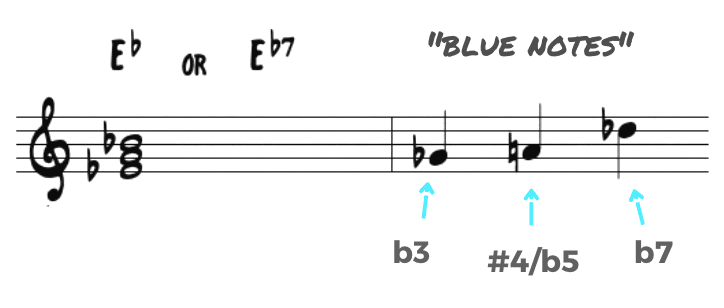
Notice how the melodic phrases in this tune emphasize “blue notes” specifically emphasizing the b3, (#4) b5, and b7 of the tonic key:

To ingrain these sounds, start by learning and hearing these blue notes in every key (b3, b5, b7):

You can play these notes along with a drone tone of the root to hear the unique sonority of each note.
Then practice some of the other lines and take them through all keys. You might start with the last phrase in the melody of Sandu, focusing on where the “blue notes” occur:
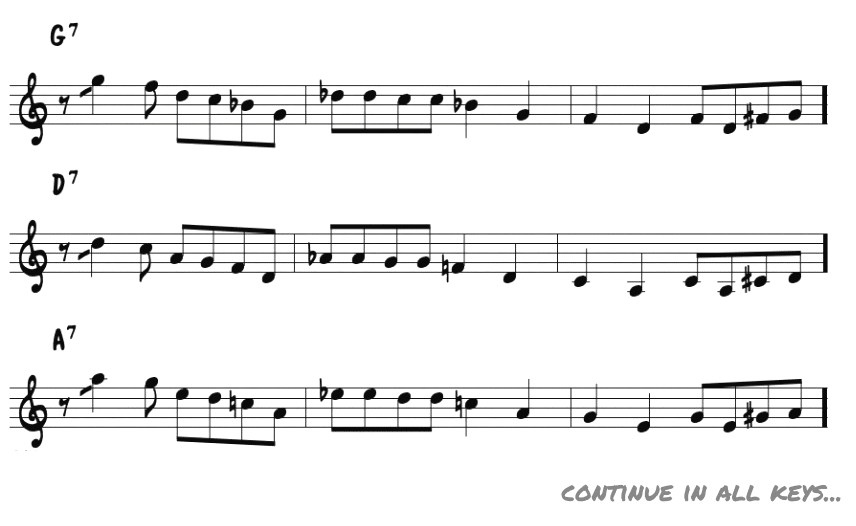
This will give you some solid blues statements and common blues vocabulary to work with in all keys that you can apply not only to the blues, but any tune that you play.
3. Placing blues statements within the I to IV movement
The melody to Sandu also navigates the movement from I to IV with the same concept we looked at in Tenor Madness, but this time in the context of blues statements.
To see what I mean, check out how the opening line of the melody relates to the underlying I and IV chords:

You see the G on the I moving to Gb on the IV chord and back again to G natural in the next measure, highlighting the movement between the major and minor 3rd in the home key.
This happens again in the next phrase of the melody as well, emphasizing the Gb on the IV chord and the G natural on the I chord:

Keep in mind that you can use blue notes or minor 3rds on any chord you hear them in, however utilizing this half-step movement between I and IV can be a useful technique in crafting your musical ideas.

III. Billie’s Bounce
The final blues head we’ll look at is Charlie Parker’s blues, Billie’s Bounce…
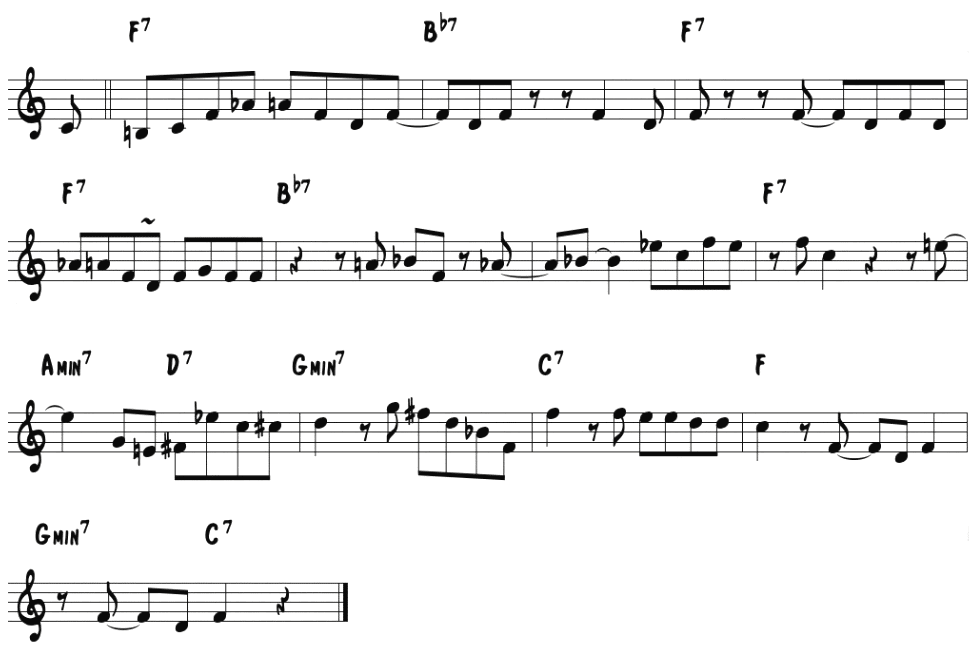
With this melody you’ll notice a mix between melodic statements and blues language all combined in a more linear approach. Let’s take a closer look…
1. The iii-VI leading to the ii in the blues
Along with the ii-V, the other transition point you should master in the blues is the iii-VI progression in the 8th bar:
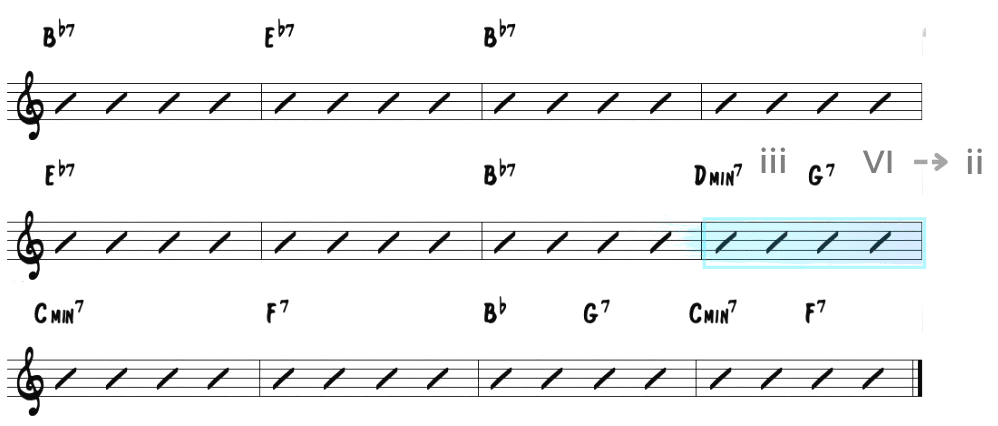
This measure is a harmonic bridge that naturally leads to the ii chord in the 9th bar and is a useful spot to aim for as you create your phrases.
Check out how the melody of Billie’s Bounce highlights this progression:

In this melodic line, the sound of the major 7 on the iii chord signals a change in the harmony moving to the end of the form and smoothly leads into the ii chord.
Notice the descending half-step motion in this line, moving from the 5th of the A-7 to the b9 on D7 to the 5th of G-7.

Mastering this iii-VI transition in the Blues is essential for any soloist. Here are a few practice ideas to ingrain this progression in your playing. Start by visualizing and hearing this iii-VI progression in relation to the tonic key of the blues in all keys:
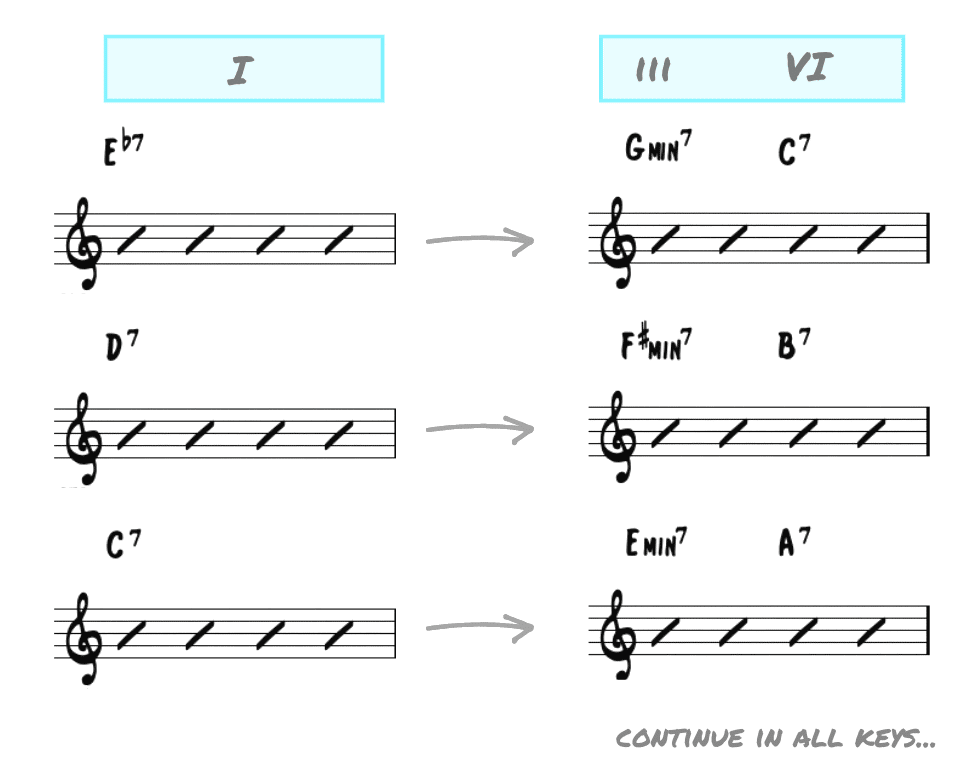
Next, develop language for the iii-VI progression in all keys, starting with the composed line in Billie’s Bounce. Think of the related tonic key of the blues as you practice each iii-VI in a new key:

*Want to quickly understand & master progressions like the iii-VI and dozens of other essential harmonic relationships in the jazz repertoire?? Check out our newest course Jazz Theory Unlocked…

2. Phrase over the larger form instead of individual chords
One aspect of creating a solo over a tune, especially the Blues, is learning how to craft your phrases over the larger song form.
Specif, you need to zoom out from the chord to chord approach and figure out where you want to place your musical ideas within the form as a whole.
Listening to the melody of Billie’s Bounce you can hear 3 larger phrases of melody:
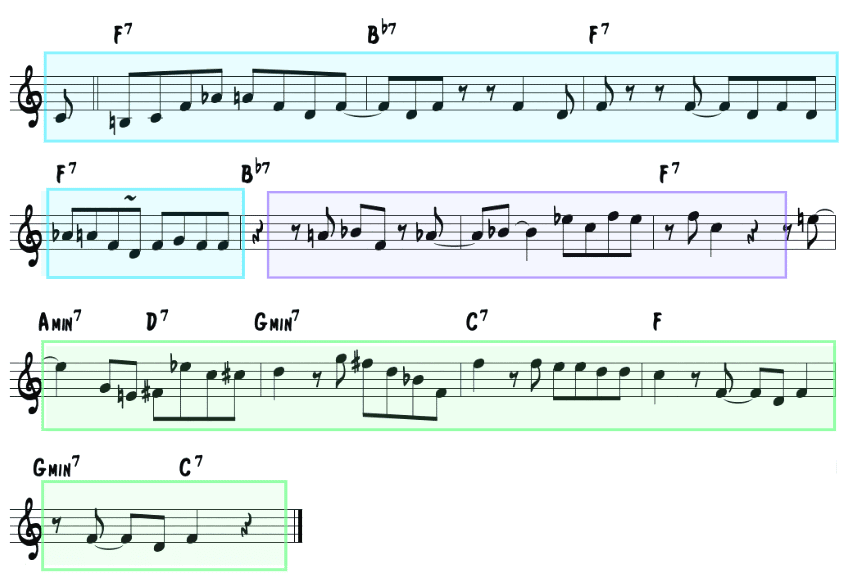
These 3 sections are (1) the opening four measures centered around I chord, (2) the transition to the IV chord, and (3) the iii-VI-ii-V resolving to I at the end of the chorus:

Mapping out your solos in these three larger sections will help you in phrasing over the 12 bar form as a whole and will lead to some different creative directions in your approach.
Let’s think about each of these sections a little more…
1) Statements over I chord
The opening four bars are where you’re going to make your initial ideas over the tonic sound in the blues. This is the perfect spot for one of the blues statements you learned above!
Because you are not worried about individual chords or resolving each sound here, you can just make a musical statement somewhere in the first four bars:

You might use a pick up to the first measure, aim for the 2nd bar, or freely place your phrase somewhere in the four measure segment. Check out the phrasing of the original melody over the first section of the blues:

2) Moving to the IV chord
The second section on the IV chord is a place to make an answer to your initial statement, or to contrast it and add tension.
This is a great place to emphasize the minor 3rd, b5, and other blue notes, contrasting the major 3rd of the I chord.
Listen to how the original melodic line in this next section:

3) The iii-VI-ii-V resolving to I at the end of the chorus
In the final section you are going to conclude your musical idea, resolving to the end of the chorus.
This is the spot to utilize your iii-VI and ii-V language and techniques. Listen to how the final phrase of Moose the Mooche navigates this final spot in the blues:
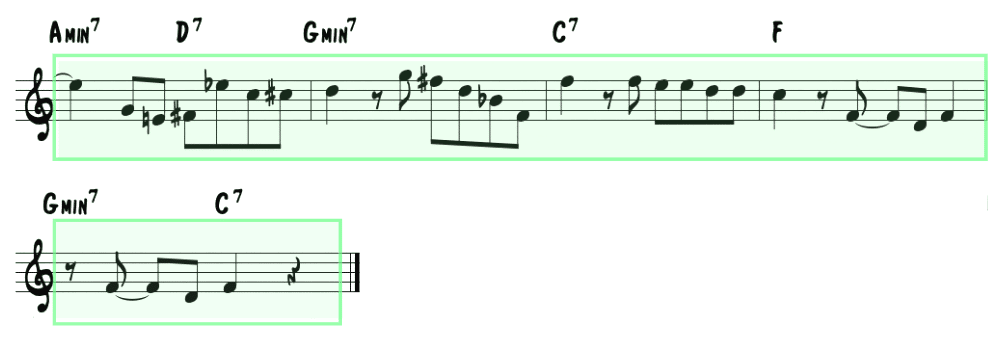
Keep in mind that these 3 sections are just one approach, you can visualize 4 larger chunks, etc. or treat the entire chorus as a blank canvas for your musical ideas.
The main idea is that by detaching from the traditional chord to chord approach, you’ll find yourself with more rhythmic and melodic freedom over these bigger chunks of music
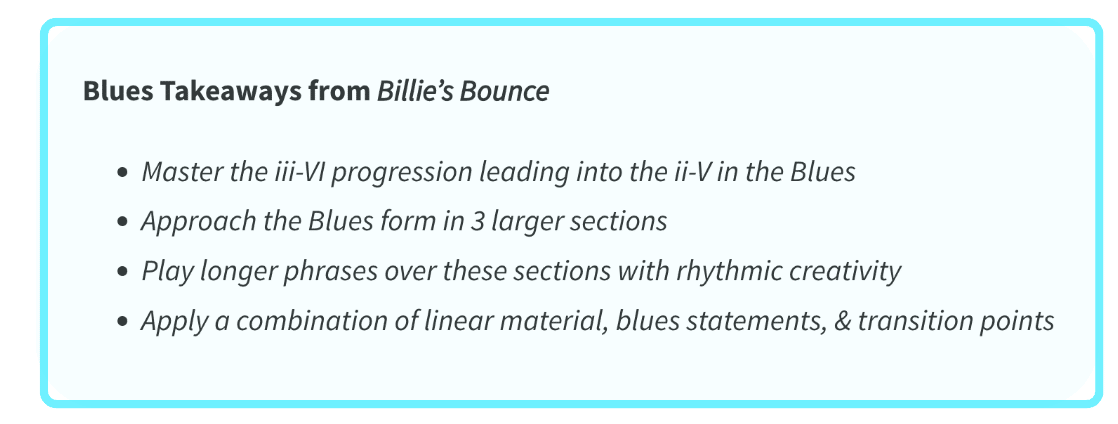
By completely learning these 3 melodies and ingraining the musical concepts they contain in all keys, you’ll come away with a solid foundation for playing the Blues.
For more study on the blues, check out three two lessons:
- 8 Awesome Blues Solos for Beginners to Transcribe
- How to Play the Blues Like a Pro: A Lesson with Wynton Kelly
- Eight Improvisation Techniques Mark Turner Uses on the Blues
Rhythm Changes
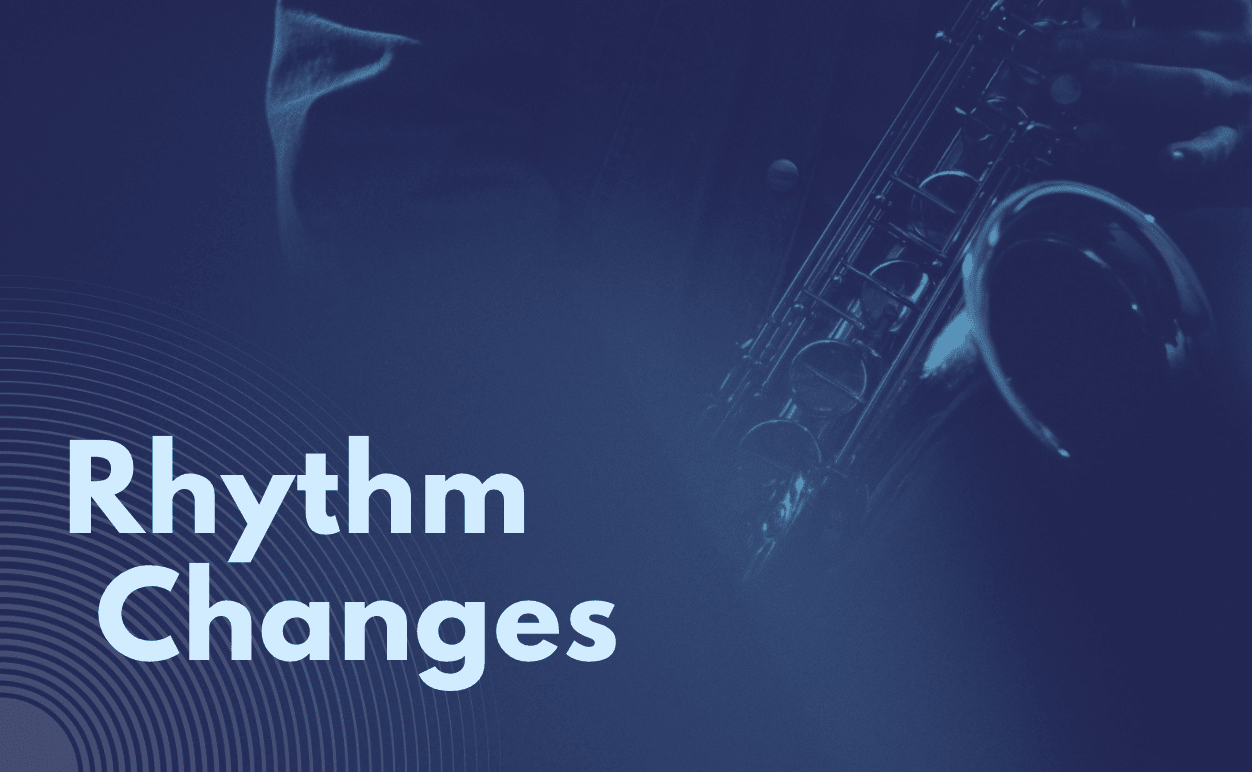
Along with the Blues, another song form that is essential for every improviser to know is Rhythm Changes – the 32 bar AABA form based on the progression to Gershwin’s I Got Rhythm.
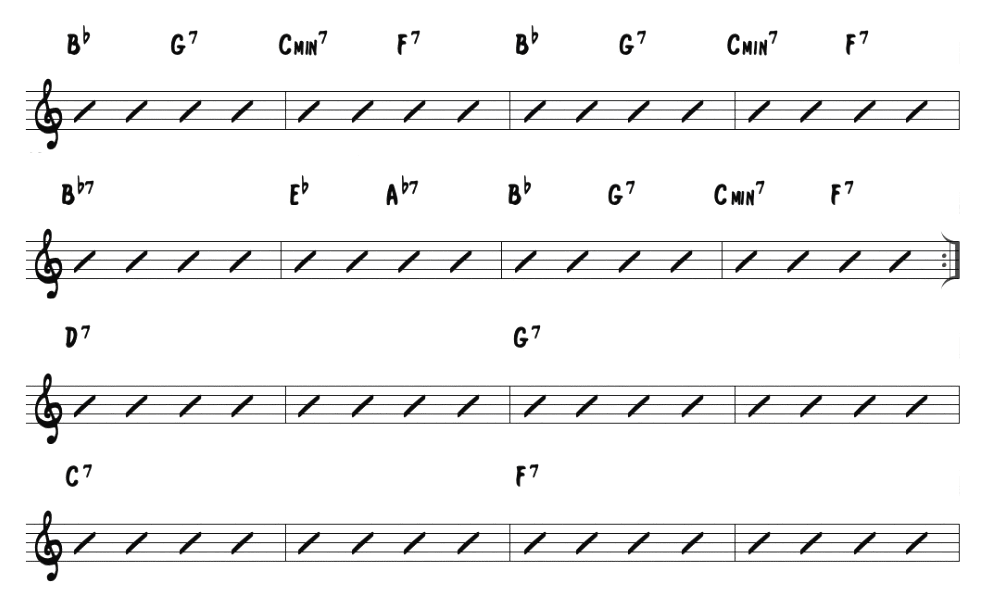
And just like the blues, without a sense of the harmonic relationships, form, or melodic tradition, it’s just another set chords to guess at.
This is where learning and studying a few well-known melodies will reveal powerful techniques for learning the form and creating your own solos.
Below we’ll look at 3 Rhythm Changes melodies, focusing specifically on the A section, and the musical secrets they contain…
I. Moose the Mooche
The first tune we’ll study is Charlie Parker’s rhythm changes head, Moose the Mooche:
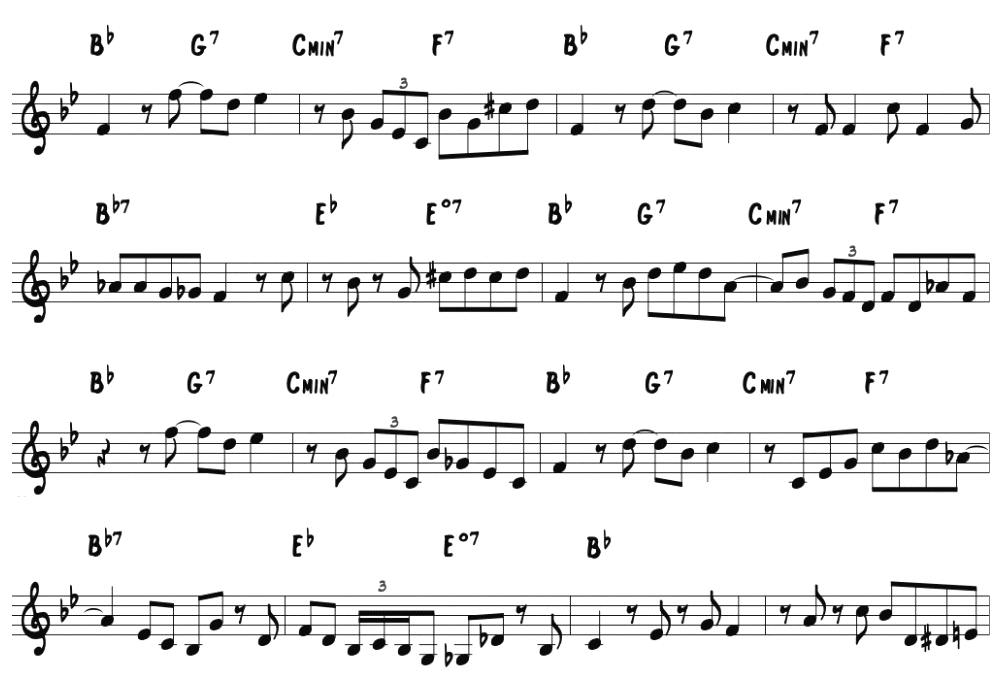
1. A simpler approach to the first 4 bars
What you might notice right away is that the melody isn’t “hitting” every chord and is mostly composed of diatonic material.
This is something important to remember as you create your own solos on Rhythm Changes – you don’t have to play every single chord.

This approach can feel overwhelming and often can sound like a theory exercise when you try to solo over it. The trick is to simplify the progression and focus on the bare bones harmonic movement.
The progression of this tune is in the larger key of Bb, and the secret to simplifying your approach lies in understanding how each chord is operating within this key and is functioning on top of a very progression.
At it’s core, the fundamental harmonic movement in the first four bars is I-V-I…

And as you see below, the melody of Moose the Mooche approaches the progression in the first 4 bars as I-ii-V-I:

Listen to how this melody navigates the opening 4 bars of the form over the I-VI-ii-V progression central to Rhythm Changes:

And the phrase in the second A section:

In both cases you see a simple statement on the Bb chord and then a ii-V in the next measure that resolves to Bb again, I-ii-V-I. The VI chord is simply ignored in a melodic sense and the entire measure is treated as the I.

A simplified harmonic approach like this will allow you to be more rhythmically creative as opposed to trying to hit every single chord that goes by.
Try applying this technique to the first four bars of Rhythm Changes. To start, make a simple musical statement on the I chord, then play a ii-V leading back to the I again:

Take this idea through all keys. When that feels comfortable start practicing the original melodic line in all keys…

2. Navigating the 5th and 6th bars
Another part of the A section in Rhythm Changes that can be tricky to navigate, starts in the 5th bar:
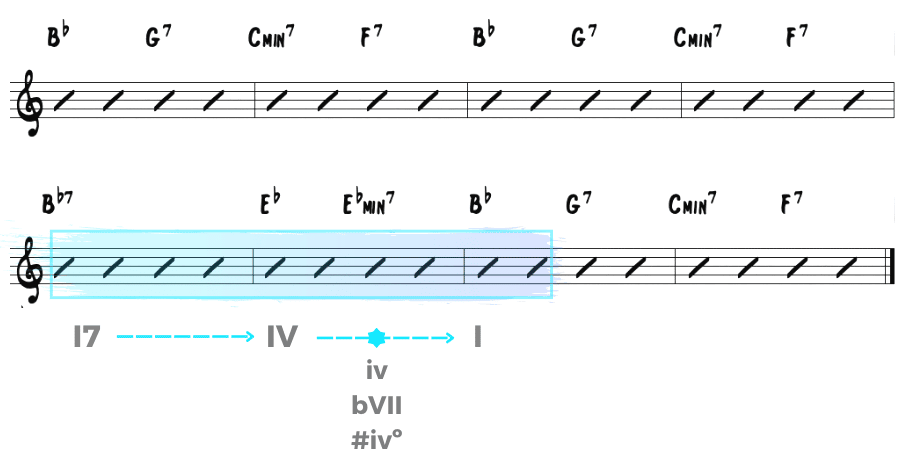
Here you’ll find a I7 dominant chord that resolves to the IV chord, and then moves back to I. Check out how the melody of Moose the Mooche navigates this spot:

In this line, the I7 chord resolves to IV, moves to the parallel iv minor which in turn resolves back to I via a back door ii-V (Eb- Ab7 to Bb).
This melodic line is an effective way to navigate this tricky progression and one that would be valuable to learn in all keys.
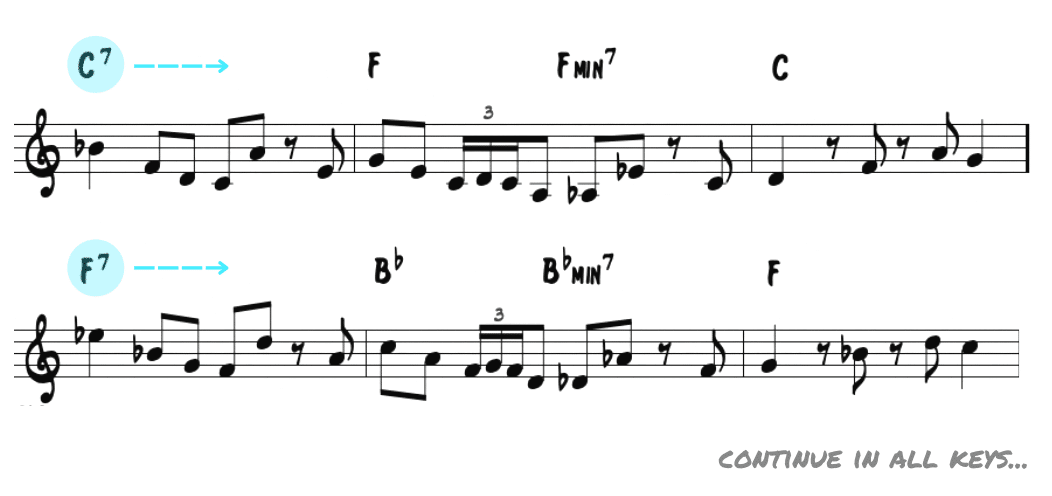
And as we’ve shown above, you don’t always have to navigate every single chord in a progression, just like the first part of this tune:

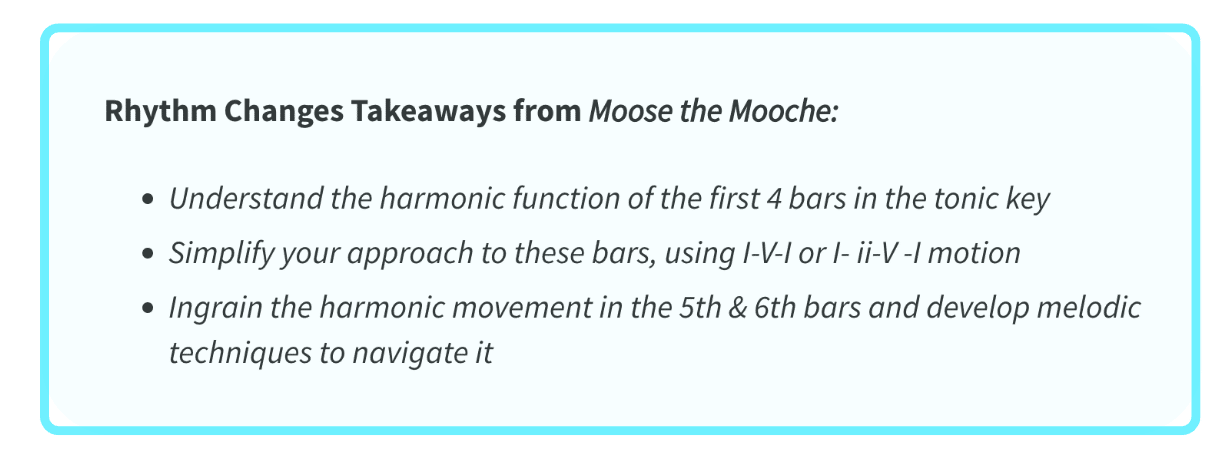
II. Wee /Allen’s Alley
The next Rhythm Changes tune we’ll study is Denzil Best’s bebop head Wee also called Allen’s Alley.
Check out Stan Getz’s version recorded with Dizzy Gillespie below…

Approach the ‘A’ section in the tonic with diatonic material
As we highlighted in Moose the Mooche, you don’t have to play every chord in the ‘A’ section of Rhythm Changes.
But you can take this concept even further, approaching the entire A section in the tonic key with diatonic material…
In your melodic approach to the harmony of rhythm changes, you can think about musical statements in the larger tonic key.
Even though you are using diatonic material, you are still hearing the progression go by and know exactly where you are in the form. Notice how the melody of Wee lines up with the arrival points in the progression:
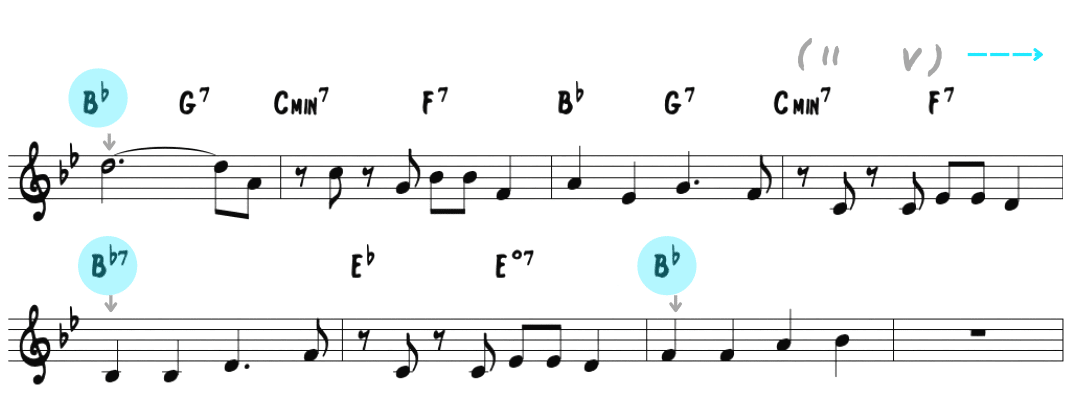
Starting on the 3rd of the chord, arriving on the I7 chord, and ending the phrase at the resolution to I – following the larger structure of the progression without being tied to every single chord.
It’s not that you’re mindlessly playing the tonic major chord over the entire progression, rather you’re hearing the movement of the form and each chord go by, knowing exactly where you are. On top of all of this you are creating musical statements.
This is similar to other Rhythm Changes tunes like I Got Rhythm or tunes like Oleo, Rhythm’n’ing, and Cottontail, and an approach that you can apply to your own solos as well.
Practice approaching the A’s with diatonic statements, start with simple ideas. Begin by visualizing the A section to Rhythm Changes in different keys with the understanding that each chord relates back to the tonic key:
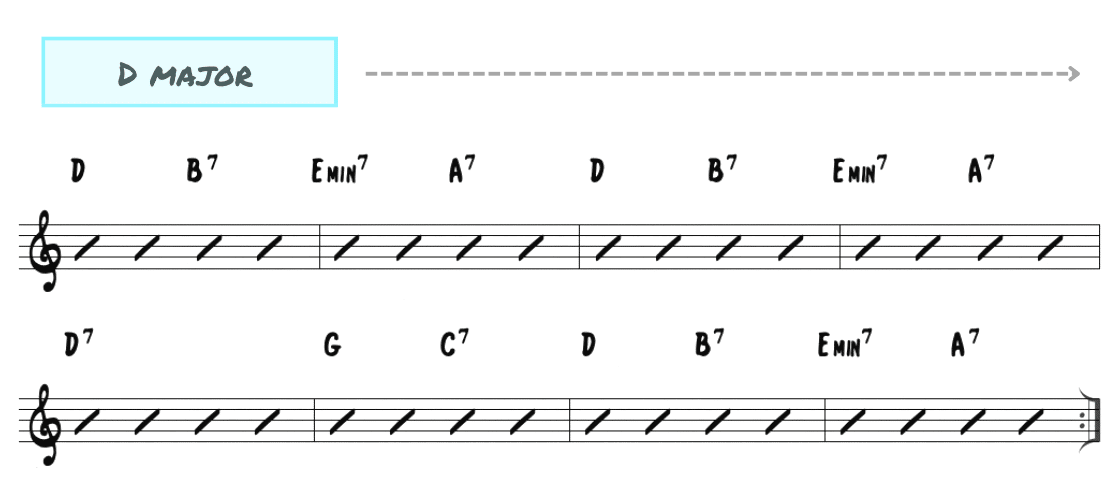
Then practice taking a simplified diatonic approach to melodic construction in these bars, imitating a melody like Lester Leaps In that uses a diatonic or major pentatonic approach:

Finally, slowly learn the melody to Wee in all keys:
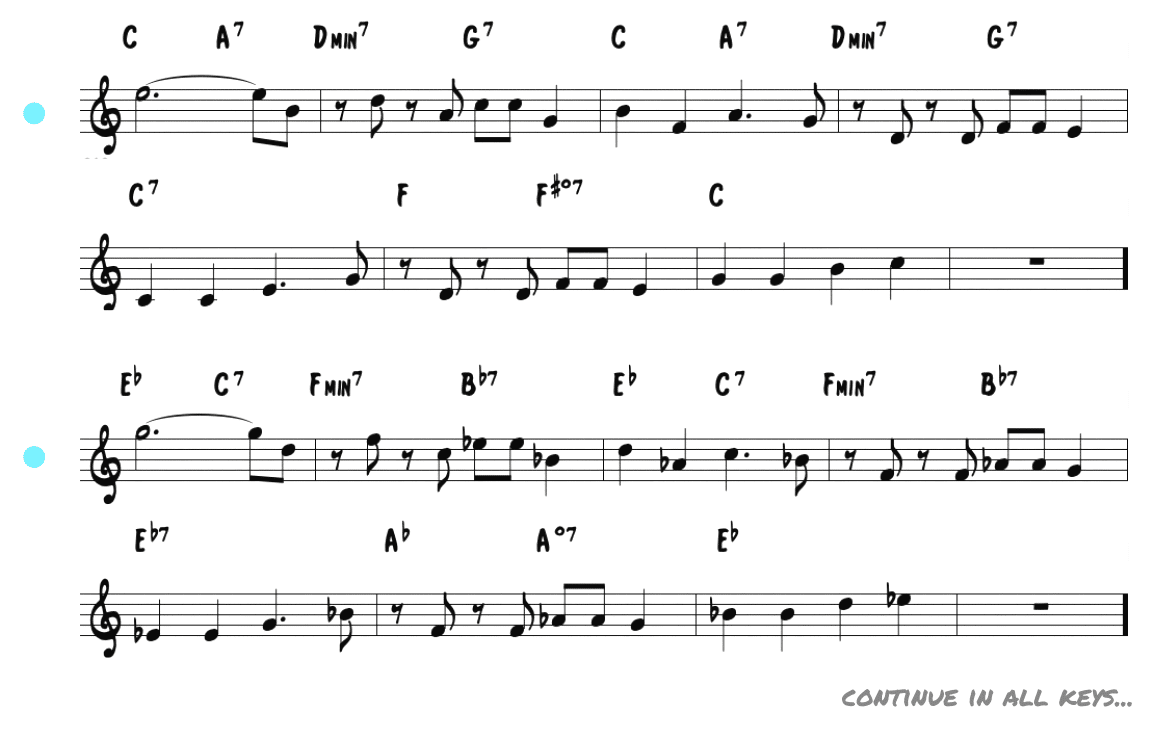
Keep in mind that you can even approach the A with blues statements in the tonic like you saw with the melody to Sandu, and this is a technique that you hear in many great solos and a good way to vary your approach to the tune.
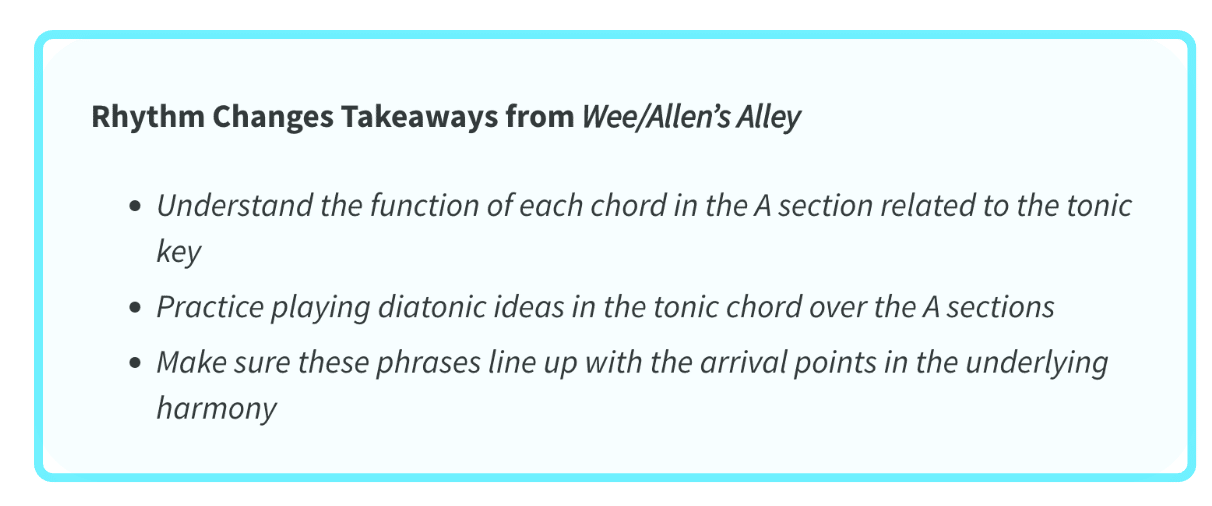
III. Room 608
The last Rhythm Changes melody we’ll take a look at is Horace Silver’s tune Room 608…
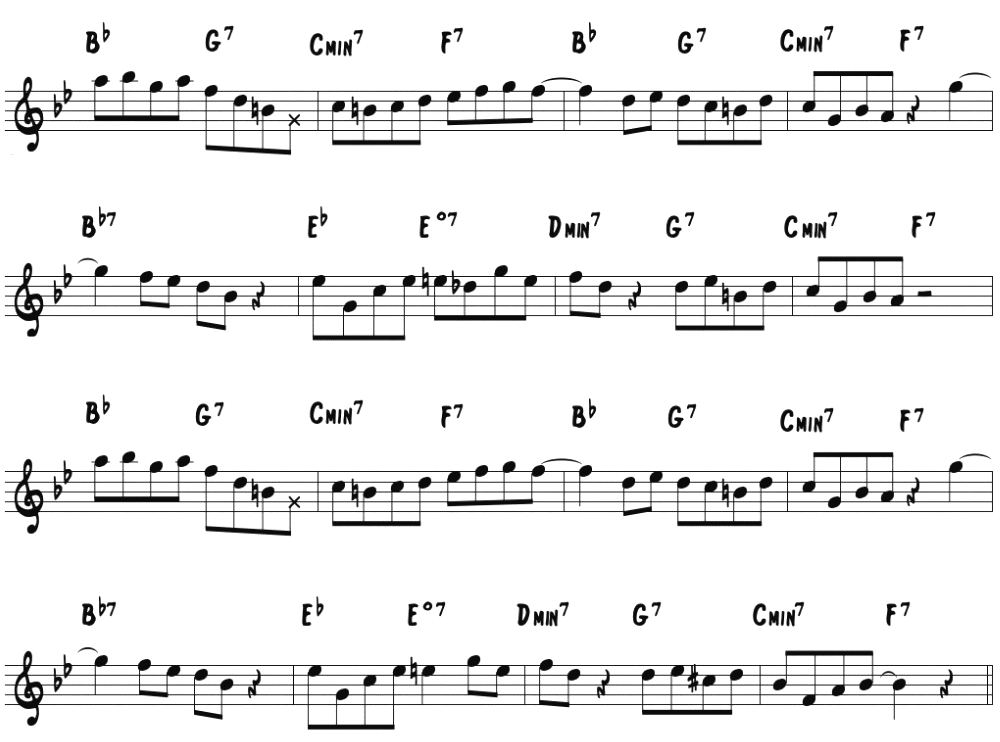
1. Develop a linear approach to I-VI-ii-V
One skill you need as an improviser working on Rhythm Changes is the ability to play melodic lines over a I-VI-ii-V-I progression.
Before you can get creative with this you need to have some lines and techniques ingrained over this common progression.
Check out this lesson on turnarounds for some insight into the construction of and variations on the I-VI-ii-V progression.
The melody to Room 608 is a great model for developing a linear approach to the A section of this song form. Check out the opening four bars:

A great practice exercise would be to breakdown this phrase in to the two corresponding I-VI-ii-V lines and practice them in every key, starting with the first two bars…

And then the next two bars…

The goal is to ingrain this entire line in Bb, then every other key. This is one line you’ll have to navigate first 4 measures in a linear way, the next step is to find more I-VI-ii-V lines to learn!
2. A linear approach to the last 4 bars of the A
The other notable part of this melody is its melodic eighth note approach to the second four bars of Rhythm Changes.
Take a listen to the line below:

Over the same I7 to IV to I motion, this melody highlights the IV to #viº movement in the second bar. This is a chord variation that you should know in this spot and this melodic line is an effective one to add to your approach.
The overall goal is to be able to approach Rhythm Changes in three different ways:
- To be able to play flowing lines that navigate each chord
- To play melodic ideas in the larger tonic key
- …and to do a combination of both!
The melodies above give you the harmonic and melodic tools to do exactly this. And by mastering these concepts in each key, you will develop tools not only for navigating Rhythm Changes, but any other tune in the jazz repertoire.
Looking for more practice on Rhythm Changes? Check out these lessons:
The melody is more than notes
As an improviser, it can be overwhelming trying to deal with the endless lists of jazz standards to learn…
Before you know it, you’re in the habit of simply memorizing the notes of a melody and moving on.
But remember, these melodies hold the key to improvising over the forms and progressions you’ll encounter in the jazz repertoire!
Melodies and tunes aren’t a separate endeavor on your journey to build your improvisation skills, they are vitally connected.
There is enough musical information and techniques contained in the melodies of any well known jazz standard to teach you everything you need to know as an improviser…
The trick is taking the time and effort to actually look for it and develop it!
If you take the lessons we learned from the melodies above, you’ll have more than a solid start to playing Blues and Rhythm Changes in a musical way.

